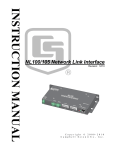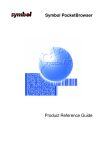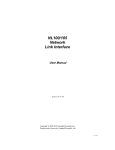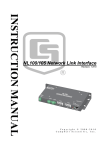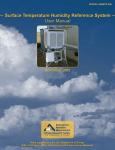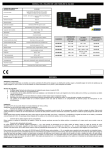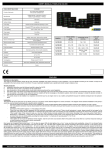Download Campbell RWIS STATIONS Instruction manual
Transcript
INSTRUCTION MANUAL RWIS Stations 3/05 C o p y r i g h t ( c ) 2 0 0 5 C a m p b e l l S c i e n t i f i c , I n c . Warranty and Assistance The RWIS STATIONS are warranted by CAMPBELL SCIENTIFIC, INC. to be free from defects in materials and workmanship under normal use and service for twelve (12) months from date of shipment unless specified otherwise. Batteries have no warranty. CAMPBELL SCIENTIFIC, INC.'s obligation under this warranty is limited to repairing or replacing (at CAMPBELL SCIENTIFIC, INC.'s option) defective products. The customer shall assume all costs of removing, reinstalling, and shipping defective products to CAMPBELL SCIENTIFIC, INC. CAMPBELL SCIENTIFIC, INC. will return such products by surface carrier prepaid. This warranty shall not apply to any CAMPBELL SCIENTIFIC, INC. products which have been subjected to modification, misuse, neglect, accidents of nature, or shipping damage. This warranty is in lieu of all other warranties, expressed or implied, including warranties of merchantability or fitness for a particular purpose. CAMPBELL SCIENTIFIC, INC. is not liable for special, indirect, incidental, or consequential damages. Products may not be returned without prior authorization. The following contact information is for US and International customers residing in countries served by Campbell Scientific, Inc. directly. Affiliate companies handle repairs for customers within their territories. Please visit www.campbellsci.com to determine which Campbell Scientific company serves your country. To obtain a Returned Materials Authorization (RMA), contact CAMPBELL SCIENTIFIC, INC., phone (435) 753-2342. After an applications engineer determines the nature of the problem, an RMA number will be issued. Please write this number clearly on the outside of the shipping container. CAMPBELL SCIENTIFIC's shipping address is: CAMPBELL SCIENTIFIC, INC. RMA#_____ 815 West 1800 North Logan, Utah 84321-1784 CAMPBELL SCIENTIFIC, INC. does not accept collect calls. CS500 Table of Contents PDF viewers note: These page numbers refer to the printed version of this document. Use the Adobe Acrobat® bookmarks tab for links to specific sections. 1. General ........................................................................1 2. Specifications .............................................................1 2.1 Temperature Sensor ..................................................................................1 2.2 Relative Humidity Sensor .........................................................................2 3. Installation...................................................................2 4. Wiring ..........................................................................6 5. Example Programs .....................................................6 5.1 Example for CR1000 ................................................................................7 5.2 Example for CR10X .................................................................................7 6. Long Lead Lengths.....................................................8 7. Absolute Humidity ......................................................9 8. Maintenance ..............................................................11 9. References ................................................................11 Figures 1. 2. 3. 4. 5. CS500 and 41301 Radiation Shield on a CM6/CM10 Tripod Mast ...........3 CS500 and 41303 Radiation Shield ............................................................4 CS500 and 41003 Radiation Shield on a CM6/CM10 Tripod Mast ...........4 Radiation Shield, CS500, and 41381 Adapter ............................................5 CS500 Wiring .............................................................................................5 1. 2. 3. 4. 5. Datalogger Connections..............................................................................6 Calibration for Temperature .......................................................................6 Calibration for Relative Humidity...............................................................6 Wiring for CR1000 and CR10X Examples.................................................7 CR10(X) Wiring for Example 1..................................................................9 Tables i This is a blank page. RWIS Stations Campbell Scientific RWIS stations are intended to automatically collect weather and road information. Standard met sensors are used with surfacespecific sensors to measure additional site conditions. As with all Campbell Scientific stations, these are configurable by the customer to their requirements. RWIS stations conform to national standards defined by the National Transportation Communications for ITS Protocol (NTCIP). They have developed standards for implementation of several aspects of RWIS. The NTCIP guide is available at http://www.ntcip.com/library/guide.asp. The specification that we conform to is ESS-1204. ESS (Environmental Sensor Station) is a term that refers to the weather station. Each station that we supply has the following components listed below. Power enclosure for the batteries: AC recharge DC recharge/tripod for solar panels Equipment enclosure: CR10X-2M or CR1000 SDM-SIO4 NL110 Modem In addition to the standard met sensors, there are options that add function to the station to allow it to make road-related measurements. Some are listed below. As with any station, if a customer needs another measurement that they feel is appropriate, it will be added if possible. SR50 (acoustic snow sensor) Lufft IRS21 (road sensor – 2 ea generally) Present weather (such as Vaisala PWD22) Camera 107 probes for sub surface temperatures The purpose for the instruments in the equipment enclosure doesn't need a lot of explanation with the exception of the SDM-SIO4 and the modem. The SDM-SIO4 is used primarily for interfacing to the IRS21. The handshake required to communicate with the sensor doesn’t allow for operation with the CR10X alone since four control ports are required. In addition, many of the sensors used with this application have serial interfaces making the SDM-SIO4 a good addition to the application. The modem used needs an RS-232 interface and also needs to be faster than the 9600 baud offered in Campbell modems. This is due to the requirement for image retrieval from a camera. If using FTP (desired) to extract an image from the logger, FTP shuts down before the image can be retrieved. 1 RWIS Stations Theory of operation The NL110 provides communication for all system devices, converts logger measurements to NTCIP compliant data, routes images from an installed camera to the logger, provides SNMP communication, and stores text generated in the CR10X to text values required by NTCIP. Customers call in through the modem and establish a PPP connection. This connection makes a private network and has its own IP address. The NL110 also provides the necessary function for providing NTCIP compliant data to ANY NTCIP compliant software that can interrogate NTCIP compliant systems. This makes the RWIS system compatible with other systems supplied by other manufacturers. The logger makes all measurements. As they are made, output is generated that the NL110 accepts. The NL100 then converts the data to NTCIP compliant values by changing the variable names to variable names that comply with the specification. The camera installed outputs an image automatically on a fixed interval. As the image is sent, it is routed from the camera to the 10 base t input on the NL110. The NL110 then routes the image to the logger for later use. One image is stored in the logger, and when a new image is sent, it replaces the image last sent. All sensors have their own measurement instructions, but there are some unique setups for the equipment installed in the ESS. The following pages describe those setups. 2 RWIS Stations Loggermap diff channel 1 2 3 4 5 6 se channel 1H 2L 3H 4L 5H 6L 7H 8L 9H 10L 11H 12L p1 p2 e1 e2 e3 c1 c2 c3 c4 c5 c6 c7 c8 sensor/color function humidity Air temp open option(oo) wind direction solrad solrad sub surface sub surface sub surface sub surface rain y/n(oo)* rainy/n(oo)* wind speed tipping bucket 12v/color AG/color G/color sub surface wind direction sdm-sio4 sdm-sio4 sdm-sio4 snow depth Logger Setup The CR10X-2M *D and *A menus set the logger for image collection and pb operation. *D15 location 1 is the pakbus address and is set to 1 fill in the remainder of the table with values of 4 *D16 location is the amount of memory to set aside for the image in the logger and is set to 6 *D18 location is the beacon and is set to 60 *D19 location 01 is set to 17 with nothing after *A location 6 is set to 3000 for the text values that ess1204 requires 3 RWIS Stations NL110 Setup NL100/105: TLink config: [RS232] RS485 config: [disabled] CS I/O config: [PakBus] CS I/O SdcAddr/bps: [SDC7] CS I/O beacon interval (sec): [60] RS232 config: [PPP] RS232 bps: [38k] EtherNet 10BASE-T: [enabled] 10BASE-T port IP address: [192.168.7.53] 10BASE-T port network mask: [255.255.255.0] Is there a default gatway: [no] PakBus node Id: [678] Clock neighbor node Id: [1] PakTcp server config: [enabled] PakTcp server port number: [4001] PakTcp client config: [disabled] Configuration monitor telnet port: [23] Telnet session password: [nl100] Serial server watchdog (minutes): [2] Power Saving Mode: [disabled] MODBUS/TCP gateway config: [disabled] SNMP Version 2: [enabled] Logger ID for PakBus: [1] PMPP PC Address: [50] Network Address for PPP: [192.168.18.150] Network Mask for PPP: [255.255.248.0] PPP Password (Max. 8 characters): [ntcip] Enable Ethernet Port: [enabled] Set Modem Answer Rings (1: default): [1] Modem Initialization: [AT] NL100/105 (ver, last, curr, show, edit, defaults, reset, help, bye): 4 RWIS Stations Dial up Setup 5 RWIS Stations 6 RWIS Stations Collecting the image as data When FTP cannot be used for image removal from the logger, cora_cmd can be. In this case the image is treated just like data in that it is downloaded during a task for routine data removal or by itself in a task. The following batch files are used. The files in the images below have different names, but do the same thing. If you’re going to get data and a picture during the same call, the following set up can be used in the Loggernet tasks. User may or may not be needed for the function. All files need to be placed in the programs\campbellsci\loggernet directory 1. connect with rasconnect 2. connect to the station and collect the data 3. execute pictask.bat which in turn calls getpic.txt to retrieve the image 4. disconnect with rasdisconnect Rasconnect.bat RASDIAL rwis1 user Rasdisconnect.bat RASDIAL rwis1 /DISCONNECT Getpic.txt connect localhost; get-file rwispbadr1 CRD:netcam.jpg.tmp --save-as=c:\campbellsci\loggernet3\netcam.jpg; exit; pictask.bat c:\"program files\campbellsci\loggernet3\cora_cmd.exe" <getpic.txt>what.log 7 RWIS Stations 8 RWIS Stations 9 RWIS Stations FTP image retrieval To FTP an image from a logger C:\Documents and Settings\donbrown.CSI-INTRANET>ftp 192.168.18.150 Connected to 192.168.18.150. 220 FTP server ready. User (192.168.18.150:(none)): ntcip 331 Password required. Password:ntcip 231 User name accepted. ftp> get netcam.jpg.tmp netcam.jpg 200 OK. 150 ready to send file. 226 closing. ftp: 10796 bytes received in 9.92Seconds 1.09Kbytes/sec. ftp> 10 RWIS Stations The image is sent to the default directory. Ayantra Modem Setup Ayantra IML560 Switch 1 2 3 4 5 6 7 8 9 10 11 12 Position off on off on off off off on on off off off The modem is set to 38.4kb to match the speed of the serial port on the NL110. CAUTION Be aware that the power connector of the Ayantra modem is the same as for our loggers, except that the connections are reversed. Be certain to wire the power of the modem according to the label on the modem. 11 RWIS Stations Blackbox Modem Setup Blackbox MD3200A setup for use with Rwis stations Follow the manual instructions for configuring the modem Set the following AT&F1 ATS0=1 ATS46=136 AT&D0=0 AT&W Netcam Setup 12 Sets the default values Answers after 1 ring Disables compression Ignores DTR Writes the changes RWIS Stations Troubleshooting There may be times that a partial image is seen. In this case an image was being transferred to the logger, and something interrupted it. Calling in during the image transfer can cause this to happen. Ideally a polled camera would solve this problem since we could ask for an image with a control port just before a scheduled call. The problem can be minimized by scheduling image downloads at times other than scheduled calls. For an hourly schedule, if the camera is set to 13 minute downloads, interruptions of the image transfer are very seldom. 13 RWIS Stations If there is a time that the station is called but the authentication fails, the NL110 is hung and needs to be reset. This can done locally by using the NL110 configuration menu, or by programming a control port to power rest the modem on a regular interval. The control port is wired to the SW12V ctrl, and the NL110 is powered by the SW12V of the CR10X-2M. If there is a time that the phone lines are good but the connection rings busy, the modem could be hung and needs to be reset. This, too, can be managed by a power reset with the modem also being controlled by the SW12V. Connection speeds for telephones are also a concern in that speeds less that about 16kb are not practical for image retrieval. Since the modem connects to the serial port of the NL110 and the maximum speed of the serial port is 33.6kb, a modem with at least that speed is needed. Experience has shown that with speeds less than about 16kb, FTP times out and there is no image sent. Possible configurations There are two verified ways to connect to the RWIS station. The first is phone modem to NL110. Using the setups described in earlier sections reliable communication is accomplished. The second is phone modem to RF400 to NL110. In this case, a null modem is needed for connection to the base RF400 and the modem. On the logger side a straight cable is used to connect the RS-232 port of the RF400 to the RS-232 port on the NL110. Setups for the RF400s are all default with the following exceptions. Active interface – rs232 Baud rate 38.4 kb RF_ON 24ma Programming There are some requirements of ESS-1204 that require special consideration for the CR10X-2M. They are text and large numbers. Large numbers are 14 RWIS Stations converted to text with the P190 instruction, and text is created also with the P190. This is the set settings instruction, and when using this technique the 68 instruction is used to spell out the text. In both cases the form is variablename=value. There is a limit though to the amount of text that can be created. Twenty-nine characters maximum are allowed on either side of the equal sign for CR10X-2M datalogger. ESS-1204 defines all the measurements to be made. All measurements aren't required, but values have to be provided for all measurements. If a sensor isn’t part of a station, the specification requires that a no sensor value be present. The way that this is done is by writing an initialization subroutine to provide values for all sensors and creating values that correspond to the type of measurement. The subroutine is executed one time at startup or when the program is recompiled. In this way default values are already established. As sensors are added in the measurement section of the of the program, the measured values replace the default values in the output. 15 RWIS Stations This is a blank page. 16 This is a blank page. Campbell Scientific Companies Campbell Scientific, Inc. (CSI) 815 West 1800 North Logan, Utah 84321 UNITED STATES www.campbellsci.com [email protected] Campbell Scientific Africa Pty. Ltd. (CSAf) PO Box 2450 Somerset West 7129 SOUTH AFRICA www.csafrica.co.za [email protected] Campbell Scientific Australia Pty. Ltd. (CSA) PO Box 444 Thuringowa Central QLD 4812 AUSTRALIA www.campbellsci.com.au [email protected] Campbell Scientific do Brazil Ltda. (CSB) Rua Luisa Crapsi Orsi, 15 Butantã CEP: 005543-000 São Paulo SP BRAZIL www.campbellsci.com.br [email protected] Campbell Scientific Canada Corp. (CSC) 11564 - 149th Street NW Edmonton, Alberta T5M 1W7 CANADA www.campbellsci.ca [email protected] Campbell Scientific Ltd. (CSL) Campbell Park 80 Hathern Road Shepshed, Loughborough LE12 9GX UNITED KINGDOM www.campbellsci.co.uk [email protected] Campbell Scientific Ltd. (France) Miniparc du Verger - Bat. H 1, rue de Terre Neuve - Les Ulis 91967 COURTABOEUF CEDEX FRANCE www.campbellsci.fr [email protected] Campbell Scientific Spain, S. L. Psg. Font 14, local 8 08013 Barcelona SPAIN www.campbellsci.es [email protected] Please visit www.campbellsci.com to obtain contact information for your local US or International representative.






















